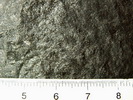Textures
Texture in geology refers to the physical appearance or character of a rock, such as grain size, shape, arrangement, and pattern at both the megascopic or microscopic surface feature level. This includes the geometric aspects and relations amongst the component particles or crystals which is called the crystallographic texture or preferred orientation. The term structure is generally used for larger features.
- Phaneritic (phaner = visible) textures are typical
of intrusive igneous rocks, these rocks crystallized slowly below the
Earth's surface. As a magma cools slowly the minerals have time to grow
and form large crystals. The minerals in a phaneritic igneous rock are
sufficiently large to see each individual crystal with the naked eye.
Examples of phaneritic igneous rocks are gabbro, diorite and granite.



- Aphanitic (a = not, phaner = visible) rocks in
contrast to phaneritic rocks, typically form from lava which
crystallize rapidly on or near the Earth' surface. Because extrusive
rocks make contact with the atmosphere they cool quickly, so the
minerals do not have time to form large crystals. The individual
crystals in an aphanitic igneous rock are not distinguisable to the
naked eye. Examples of aphanitic igneous rock include basalt, andesite
and rhyolite.

- Porphyritic textures develop when conditions during cooling
of a magma change relatively quickly. The earlier formed minerals will
have formed slowly and remain as large crystals, whereas, sudden
cooling causes the rapid crystallization of the remainder of the melt
into a fine grained (aphanitic) matrix. The result is an aphanitic rock
with some larger crystals (phenocrysts) imbedded within its matrix.
Porphyritic texture also occurs when magma crystallizes below a volcano
but is erupted before completing crystallization thus forcing the
remaining lava to crystallize more rapidly with much smaller crystals.

Photos are from http://www.przewodnicy-tatry.pl.




